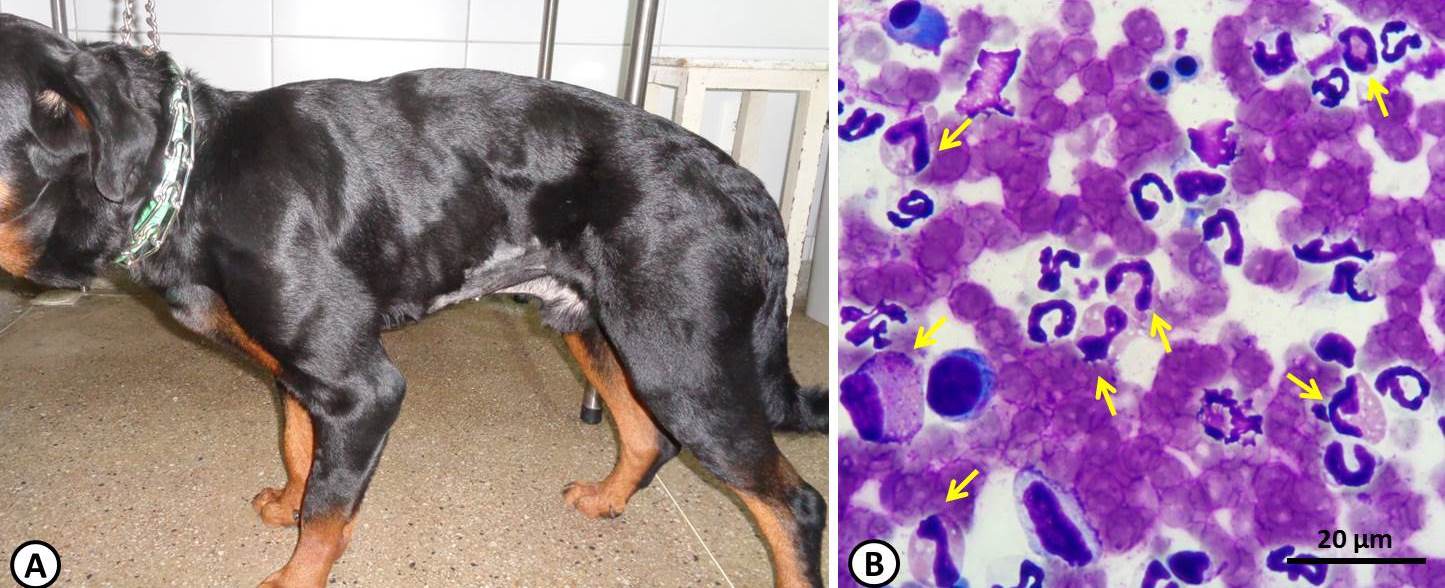Clinical, laboratory and therapeutic aspects of canine idiopathic hypereosinophilic syndrome: case report
DOI :
https://doi.org/10.21708/avb.2018.12.3.7667Résumé
The idiopathic hypereosinophilic syndrome (IHES) is a rare disease, characterized by variable eosinophilia and its massive infiltration into various organs. This study aimed to report clinical-laboratory findings and therapy in a canine with IHES. A one-year, 10-month-old male Rottweiler dog had a history of emesis, weight loss, hyporexia, and persistent eosinophilia on prior hematological exams. Vaccinations and worming were up to date. A complete blood count, serum biochemistry, bone marrow cytology, serology for leishmaniasis, chromatographic immunoassay for the detection of Dirofilaria immitis antigen, and abdominal ultrasound were requested. The tests for infectious diseases were negative. Blood biochemistry revealed no significant changes. An intense eosinophilia was observed in the hematology. A large number of cell precursors of the eosinophilic lineage were detected in the bone marrow cytology. Abdominal ultrasound showed thickening of intestinal loops. Considering the clinical and laboratory findings, the diagnosis of IHES was defined. Prednisolone treatment was instituted. The recurrence of peripheral eosinophilia occurred on the 35th day after therapy initiation. At that time, we opted to suspend the use of prednisolone and indicate the administration of deflazacort. With follow-up, therapeutic success with deflazacort was demonstrated, promoting the complete regression of clinical and ultrasound signs. The last glucocorticoid was maintained, but with a gradual dose reduction. The recognition of clinical and laboratory manifestations related to canine IHES is essential to establish an adequate diagnosis and therapy. Deflazacort emerges as a promising drug for controlling this disease.
Téléchargements

Téléchargements
Publié-e
Numéro
Rubrique
Licence
Autores que publicam na Acta Veterinaria Brasilica concordam com os seguintes termos: a) Autores mantém os direitos autorais e concedem à revista o direito de primeira publicação, com o trabalho simultaneamente licenciado sob a Licença Creative Commons Attribution que permite o compartilhamento do trabalho com reconhecimento da autoria e publicação inicial nesta revista. b) Autores têm autorização para assumir contratos adicionais separadamente, para distribuição não-exclusiva da versão do trabalho publicada nesta revista (ex.: publicar em repositório institucional ou como capítulo de livro), com reconhecimento de autoria e publicação inicial nesta revista. c) Autores têm permissão e são estimulados a publicar e distribuir seu trabalho online (ex.: em repositórios institucionais ou na sua página pessoal) a qualquer ponto antes ou durante o processo editorial, já que isso pode gerar alterações produtivas, bem como aumentar o impacto e a citação do trabalho publicado (Veja O Efeito do Acesso Livre).


 Esta obra está licenciada com uma Licença
Esta obra está licenciada com uma Licença 